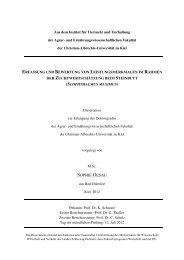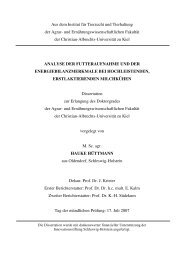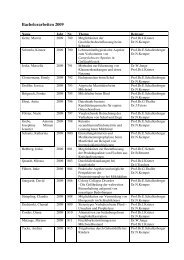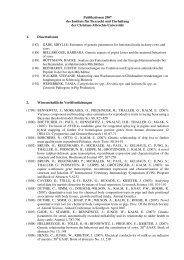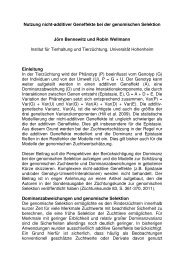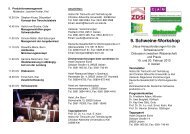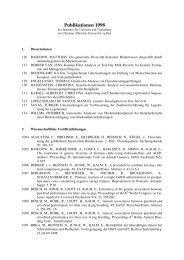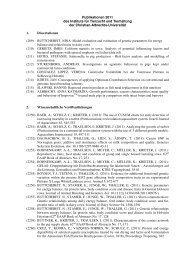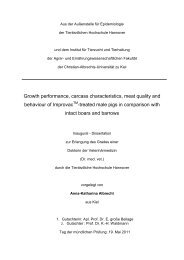Verena Gonzalez Lopez, 2011 - Institut für Tierzucht und Tierhaltung ...
Verena Gonzalez Lopez, 2011 - Institut für Tierzucht und Tierhaltung ...
Verena Gonzalez Lopez, 2011 - Institut für Tierzucht und Tierhaltung ...
Sie wollen auch ein ePaper? Erhöhen Sie die Reichweite Ihrer Titel.
YUMPU macht aus Druck-PDFs automatisch weboptimierte ePaper, die Google liebt.
Holstein. The data record included a total of 23,201 animals born from 1980 to 2009<br />
with sire and dam identification number, sex, herdbook organization and year of birth.<br />
Selection of elite animals<br />
Two selection steps were used to select elite parents for the next generation. The<br />
first, included performance and additive breeding values requirements set by the<br />
breeding organization. The second was the optimum contribution selection method,<br />
implemented in the program GENCONT (Meuwissen, 2002), to select males and<br />
females with their optimal mating frequencies to breed the next generation.<br />
1) Performance and breeding values requirements<br />
At first, potential elite animals were selected following stringent assessment of<br />
performance. Minimum requirements were determined by the representatives of<br />
SHZ. The progeny of potential elite animals, tested in the performance test station of<br />
SH, were required to have an average daily gain of >750 g, feed conversion ratio<br />
59 cm², fat to lean ratio 6. Moreover, additive breeding values of growth<br />
performance have to be positive. For a potential elite animal, the performance and<br />
breeding values had to be within the predetermined thresholds for all traits. Table 1<br />
and 2 give an overview of the performance of potential elite candidates.<br />
2) Optimum contribution selection<br />
In the second step, the optimum contribution selection method of Meuwissen (1997)<br />
was used to obtain the number of individuals to be selected and the number of<br />
offspring each of them should contribute to the next generation. The method implies<br />
a maximization of the genetic level of the next generation<br />
41<br />
G<br />
t+ 1<br />
= c'<br />
t<br />
EBVt<br />
, where<br />
t<br />
c is a<br />
vector of genetic contributions of the selection candidates to generation t + 1 and<br />
EBV<br />
t<br />
is a vector of estimated breeding values in generation t . The objective function<br />
is maximised for c<br />
t<br />
<strong>und</strong>er two restrictions. First, the rates of inbreeding are restrained<br />
to a preset level by constraining the average coancestry between selected animals to<br />
C t+ 1 = c'<br />
t<br />
At<br />
c / 2, where A t<br />
t<br />
is the relationship matrix between selection candidates,<br />
t<br />
C t+ 1 = 1−<br />
(1 − ∆F d<br />
) and ∆ Fd<br />
is the desired rate of inbreeding. The second restriction is<br />
on the sum of the contributions of male and female to 1 / 2, respectively, with<br />
Q ' c t<br />
= (1/ 2) , where Q is an n × 2 incidence matrix of the sex of the selection



